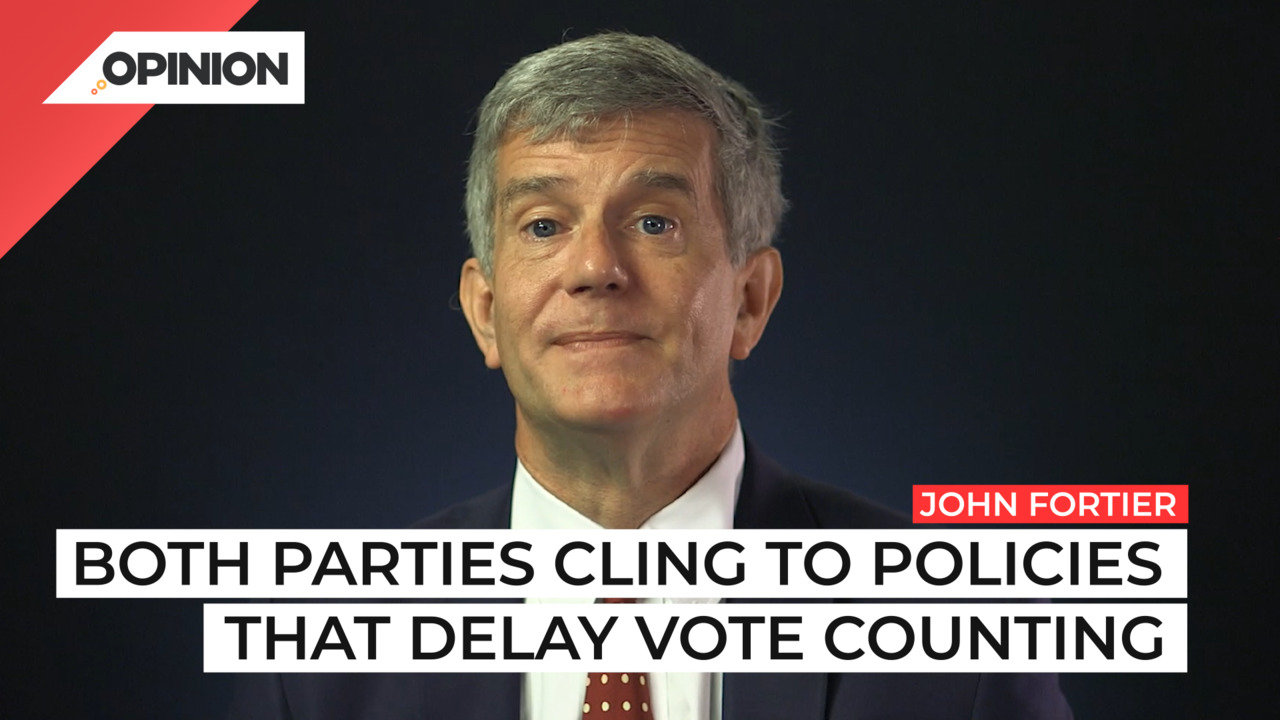
Commentary
-
Our commentary partners will help you reach your own conclusions on complex topics.
On Election night, many Americans stay up late, eagerly awaiting results. But over the last 30 years, the counting of votes has slowed significantly. Policies advocated by both parties contribute to this delay. Speed and counting of the votes is not the only value we should care about. Of course, first and foremost, the count should be accurate. But there’s no reason that we can’t have an election system that provides accuracy, transparency and speed in producing the election results.
Thirty years ago, if the average American opened the newspaper two days after the election, they would have found unofficial election results that were nearly complete. The final certified results produced later did not differ very much from these initially reported results. But that situation has changed dramatically.
Today, the percentage of votes unofficially reported two days after an election is much lower. In western states, where voting by mail is prevalent, up to 20% of votes are not reported in the first couple of days. In a few states, nearly 40% of votes are not reported in the first two days after the election. That means that voters may not know the winner of the election in a particular race for days or weeks even for races that are not very close or require a recount. In addition to this delay of initial results, in some states, the final certification of election does not occur for over a month after the election.
What’s the reason for the trend towards slower counting? The slower counting is related to the rise in voting by mail and provisional ballots. But more specifically, the slowdown occurs because many of these mail ballots are not ready to be counted on Election Day. Ballots arriving close to Election Day, or in some states after Election Day cannot be processed and counted at the same time as other ballots. How could we improve the speed and transparency of counting ballots? Both Republicans and Democrats cling to policies that delay the counting. In 2020, Republicans often voiced opposition to early processing of mail ballots. When a mail ballot arrives, the envelope needs to be checked to ensure that the voter has provided all necessary information. Is the name on the envelope on the registration list? Has the voter provided the proper address? In some states, a signature or other identification is required. In some states witnessed signatures and information are required. If there are problems with the information on the envelope, some states have a process by which the voter can be notified and be given the opportunity to fill in the correct information. If at the end of this process, the voter has met all of the requirements, the ballot can be opened, and the ballot can be placed in a machine where the ballot can be tallied on Election Day. If a state does not allow any pre-processing of mail ballots, then come Election Day, there’ll be a large stack of ballots that might take days to process and ultimately count. On the other side of the aisle, Democrats often favor allowing ballots to be counted if they are put in the mail and postmarked by Election Day, with some states accepting ballots that arrive over a week after Election Day. In a majority of states, ballots are due by Election Day, but a large minority of states accept ballots postmarked by Election Day. The problem is obvious. Ballots that arrived days after the election cannot be processed or counted until much later.
Some may say, “What is the harm in taking the time to get the count right?’ But why leave Americans waiting and speculating about reasons for delay when a couple of policy fixes would allow for accurate, speedy and transparent counts of the vote?
-
SCOTUS case on threat of disinformation raises thorny questions
The Supreme Court recently heard arguments concerning government communications with social media platforms in Murthy v. Missouri. Plantiffs in the case claim that government agencies pressured social media companies to remove or restrict posts spreading disinformation about vaccines, elections and COVID-19. Straight Arrow News contributor John Fortier delves into the complex questions raised by the…
-
Trump v. Anderson is more complicated than it looks
The Supreme Court case Trump v. Anderson will decide whether former President Donald Trump is eligible to run as a candidate for president in 2024. Some constitutional law experts have argued that Trump cannot run as a candidate, citing what they say is a clear violation of the 14th Amendment in the U.S. Constitution, which…
-
Era of Iowa, New Hampshire kicking off election season is ending
In American politics, tradition dictates that Iowa and New Hampshire kick off the election season as the two major parties elect their primary candidates. Recently, however, Democrats have suggested revising this tradition, arguing that Iowa and New Hampshire do not present an optimal, comprehensive sample of American voters, and suggesting states like South Carolina or…
-
Why the frenzy over Georgia’s voting laws was misplaced
Georgia Gov. Brian Kemp (R) changed state voting laws after President Joe Biden narrowly won Georgia’s electoral votes over former President Donald Trump in 2020. Voting advocacy groups responded and the U.S. Department of Justice filed a lawsuit against the legislation. These lawsuits alleged that the Georgia GOP in the state legislature aimed to restrict…
-
Changing speakers isn’t actually going to help Republicans
After three weeks without a speaker and three unsuccessful attempts to secure the required votes for a new one, the U.S. House of Representatives elected a little-known Congressman from Louisiana, Rep. Mike Johnson. But was the decision to elect Rep. Johnson, who leans hard-right and pro-Trump, a wise move for the Republican Party? Straight Arrow…
Latest Opinions
-
 Getty Images
Getty Images
Biden uses NFL draft ad to try to connect with young voters
-
 Getty Images
Getty Images
Powering pot: Energy for US cannabis industry could electrify 13.5M homes
-
 Getty Images
Getty Images
Allies plan for Trump to have more control over interest rates
-
 Getty Images
Getty Images
FDA: Bird flu found in 1/5 commercial milk samples, suggests greater spread
-
 Reuters
Reuters
China permanently deploys warships to second overseas base
Popular Opinions
-
In addition to the facts, we believe it’s vital to hear perspectives from all sides of the political spectrum.


